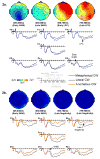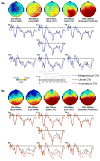Electrophysiological insights into the processing of nominal metaphors
- PMID: 20307557
- PMCID: PMC2907657
- DOI: 10.1016/j.neuropsychologia.2010.03.017
Electrophysiological insights into the processing of nominal metaphors
Abstract
We used event-related potentials (ERPs) to examine the time-course of processing metaphorical and literal sentences in the brain. ERPs were measured to sentence-final (Experiment 1) and mid-sentence (Experiment 2) critical words (CWs) as participants read and made plausibility judgments about familiar nominal metaphors ("A is a B") as well as literal and semantically anomalous sentences of the same form. Unlike the anomalous words, which evoked a robust N400 effect (on the CW in experiments 1 and 2 as well as on the sentence-final word in experiment 2), CWs in the metaphorical, relative to the literal, sentences only evoked an early, localized N400 effect that was over by 400ms after CW onset, suggesting that, by this time, their metaphorical meaning had been accessed. CWs in the metaphorical sentences also evoked a significantly larger LPC (Late Positive Component) than in the literal sentences. We suggest that this LPC reflected additional analysis that resolved a conflict between the implausibility of the literal sentence interpretation and the match between the metaphorical meaning of the CW, the context and stored information within semantic memory, resulting from early access to both literal and figurative meanings of the CWs.
Copyright 2010 Elsevier Ltd. All rights reserved.
Figures




Similar articles
-
Event-related potential evidence for the early activation of literal meaning during comprehension of conventional lexical metaphors.Neuropsychologia. 2012 Jul;50(8):1730-8. doi: 10.1016/j.neuropsychologia.2012.03.027. Epub 2012 Apr 25. Neuropsychologia. 2012. PMID: 22561889
-
Comprehension of metaphors in patients with mild cognitive impairment: Evidence from behavioral and ERP data.Acta Psychol (Amst). 2023 May;235:103894. doi: 10.1016/j.actpsy.2023.103894. Epub 2023 Mar 20. Acta Psychol (Amst). 2023. PMID: 36940588
-
Comprehending conventional and novel metaphors: an ERP study.Brain Res. 2009 Aug 11;1284:145-55. doi: 10.1016/j.brainres.2009.05.088. Epub 2009 Jun 6. Brain Res. 2009. PMID: 19505446
-
Unlocking Second Language Novel Metaphor Processing: Behavioral and ERP Insights From First and Second-Language English Users.Psychophysiology. 2025 May;62(5):e70066. doi: 10.1111/psyp.70066. Psychophysiology. 2025. PMID: 40344258 Free PMC article.
-
Concrete processing of action metaphors: Evidence from ERP.Brain Res. 2019 Jul 1;1714:202-209. doi: 10.1016/j.brainres.2019.03.005. Epub 2019 Mar 7. Brain Res. 2019. PMID: 30853628
Cited by
-
Disentangling Metaphor from Context: An ERP Study.Front Psychol. 2016 May 3;7:559. doi: 10.3389/fpsyg.2016.00559. eCollection 2016. Front Psychol. 2016. PMID: 27199799 Free PMC article.
-
Hidden Brain States Reveal the Temporal Dynamics of Neural Oscillations During Metaphor Generation and Their Role in Verbal Creativity.Psychophysiology. 2025 Feb;62(2):e70023. doi: 10.1111/psyp.70023. Psychophysiology. 2025. PMID: 39950503 Free PMC article.
-
Reversing expectations during discourse comprehension.Lang Cogn Neurosci. 2015 Jul 1;30(6):648-672. doi: 10.1080/23273798.2014.995679. Lang Cogn Neurosci. 2015. PMID: 25914891 Free PMC article.
-
Normed dataset for novel metaphors, novel similes, literal and anomalous sentences in Chinese.Front Psychol. 2022 Sep 1;13:922722. doi: 10.3389/fpsyg.2022.922722. eCollection 2022. Front Psychol. 2022. PMID: 36118442 Free PMC article. No abstract available.
-
Bilingual Processing Mechanisms of Scientific Metaphors and Conventional Metaphors: Evidence via a Contrastive Event-Related Potentials Study.Front Psychol. 2022 Jun 20;13:894114. doi: 10.3389/fpsyg.2022.894114. eCollection 2022. Front Psychol. 2022. PMID: 35795431 Free PMC article.
References
-
- Arzouan Y, Goldstein A, Faust M. Brain waves are stethoscopes: ERP correlates of novel metaphor comprehension. Brain Research. 2007;1160:69–81. - PubMed
-
- Bentin S, Bargai N, Katz L. Orthographic and phonemic coding for lexical access: Evidence from Hebrew. Journal of Experimental Psychology: Learning, Memory & Cognition. 1984;10:353–368. - PubMed
-
- Blasko DG, Connine CM. Effects of familiarity and aptness on metaphor processing. Journal of Experimental Psychology: Learning, Memory, and Cognition. 1993;19:295–308. - PubMed
-
- Bottini G, Corcoran R, Sterzi R, Paulesu E, Schenone P, Scarpa P, Frackowiak RSJ, Frith CD. The role of the right hemisphere in the interpretation of figurative aspects of language. A positron emission tomography activation study. Brain. 1994;117:1241–1253. - PubMed
-
- Brisard F, Frisson S, Sandra D. Processing unfamiliar metaphors in a self-paced reading task. Metaphor and Symbol. 2001;16:87–108.
Publication types
MeSH terms
Grants and funding
LinkOut - more resources
Full Text Sources
Medical

